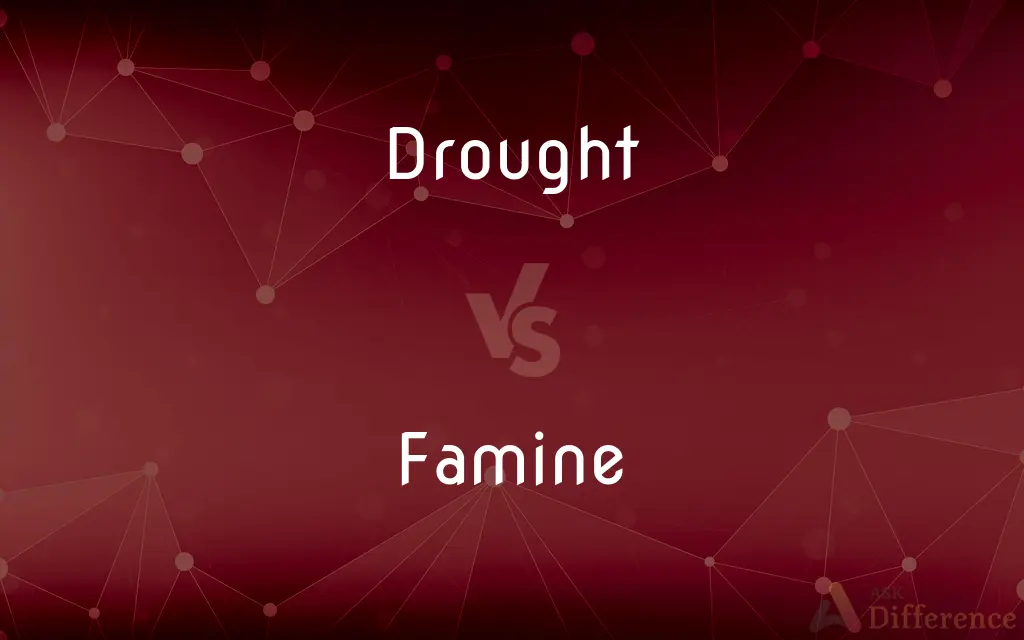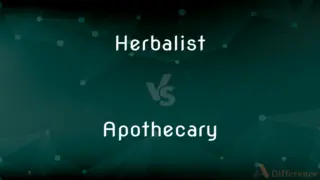Drought vs. Famine — What's the Difference?
By Tayyaba Rehman — Updated on September 18, 2023
Drought refers to a prolonged period of abnormally low rainfall, leading to a shortage of water, while Famine is an extreme scarcity of food, causing widespread hunger.

Difference Between Drought and Famine
Table of Contents
ADVERTISEMENT
Key Differences
Drought and Famine, though related, are distinct phenomena. Drought is primarily an environmental condition, characterized by prolonged periods of reduced rainfall. Famine, on the other hand, is a severe lack of food that can result in widespread malnutrition and death.
Drought often affects the agricultural sector, as the absence of regular rainfall can hinder crop growth. Famine is a more complex phenomenon, which can be caused by various factors, including drought, but also economic conditions, conflict, and poor governance.
It's important to note that not all droughts lead to famines. Effective water management, alternative crops, and irrigation can mitigate the impact of drought. Conversely, Famine can occur even without a drought, especially when socio-political factors play a significant role.
Drought, being an environmental condition, can be measured with meteorological data, examining precipitation patterns and water levels. Famine is determined by nutritional assessments, food availability, and mortality rates.
Both Drought and Famine can have cascading effects on ecosystems and societies. While Drought can lead to water shortages, soil degradation, and loss of vegetation, Famine results in malnutrition, disease outbreaks, and social unrest.
ADVERTISEMENT
Comparison Chart
Primary Definition
Prolonged absence of rainfall.
Extreme scarcity of food.
Cause
Environmental; often linked to weather patterns.
Multi-faceted; can be due to drought, conflict, economy, etc.
Measurement
Meteorological data, water levels.
Nutritional assessments, food availability, mortality rates.
Effect on Population
Water scarcity, agricultural impact.
Malnutrition, increased mortality, disease outbreaks.
Possible Solutions
Water management, irrigation, drought-resistant crops.
Food aid, economic interventions, peace resolutions, governance.
Compare with Definitions
Drought
An arid spell causing distress.
Farmers face challenges during times of drought.
Famine
An extreme shortage of something.
There was a famine of truth in his words.
Drought
A deficiency or lack in amount.
There's a drought of good news lately.
Famine
A prolonged period without something desired or needed.
A famine of creativity has hit the industry.
Drought
A prolonged period of insufficient rainfall.
The region has experienced severe drought for the past three years.
Famine
A severe scarcity of food resulting in hunger.
The country faced a famine after the crops failed.
Drought
A prolonged water shortage.
The city's reservoirs are low due to the drought.
Famine
A widespread malnutrition and mortality due to food shortage.
Many perished during the great famine.
Drought
An extended period of dryness.
Drought conditions have hindered the growth of crops.
Famine
Starvation due to food scarcity.
Children are the most affected during a famine.
Drought
A drought is an event of prolonged shortages in the water supply, whether atmospheric (below-average precipitation), surface water or ground water. A drought can last for months or years, or may be declared after as few as 15 days.
Famine
A famine is a widespread scarcity of food, caused by several factors including war, inflation, crop failure, population imbalance, or government policies. This phenomenon is usually accompanied or followed by regional malnutrition, starvation, epidemic, and increased mortality.
Drought
A prolonged period of abnormally low rainfall, leading to a shortage of water
The cause of Europe's recent droughts
Crops have failed because of drought
Famine
A drastic, wide-reaching food shortage.
Drought
Thirst
I asked for something to slake my drought
Famine
A drastic shortage; a dearth.
Drought
A long period of abnormally low rainfall, especially one that adversely affects growing or living conditions.
Famine
Severe hunger; starvation.
Drought
A prolonged dearth or shortage.
Famine
(Archaic) Extreme appetite.
Drought
A period of unusually low rainfall, longer and more severe than a dry spell.
Famine
(uncountable) Extreme shortage of food in a region.
Drought
A longer than expected term without success, particularly in sport.
Winning streak
Famine
(countable) A period of extreme shortage of food in a region.
Drought
(archaic) dryness, aridness, dry heat
Famine
(dated) Starvation or malnutrition.
Drought
Dryness; want of rain or of water; especially, such dryness of the weather as affects the earth, and prevents the growth of plants; aridity.
The drought of March hath pierced to the root.
In a drought the thirsty creatures cry.
Famine
Severe shortage or lack of something.
Drought
Thirst; want of drink.
Famine
General scarcity of food; dearth; a want of provisions; destitution.
There was a famine in the land.
Drought
Scarcity; lack.
A drought of Christian writers caused a dearth of all history.
Famine
An acute insufficiency
Drought
A temporary shortage of rainfall
Famine
A severe shortage of food (as through crop failure) resulting in violent hunger and starvation and death
Drought
A prolonged shortage
Common Curiosities
How long does a dry spell need to last to be considered a drought?
It varies; a drought is recognized based on prolonged below-average precipitation.
Are droughts always followed by famines?
No, not all droughts lead to famines; mitigation measures can prevent food shortages.
Can famine occur without drought?
Yes, famines can be caused by socio-political factors, conflicts, or economic conditions.
Are droughts natural phenomena?
Primarily, yes, but human activities like deforestation can exacerbate drought conditions.
Is climate change impacting drought frequency?
Yes, many regions are experiencing more frequent and intense droughts due to climate change.
How do droughts affect ecosystems?
They can lead to reduced water bodies, soil degradation, and loss of biodiversity.
What are some solutions to famine?
Food aid, economic interventions, peacekeeping, and improved governance can address famine.
How are famines declared?
Through assessments of food availability, nutrition levels, and mortality rates.
How can societies prepare for drought?
By investing in water conservation, drought-resistant crops, and efficient irrigation.
How can communities adapt to recurring drought?
Through sustainable agricultural practices, water management, and community education.
Are famines more prevalent in certain parts of the world?
Yes, regions with political instability or limited resources can be more susceptible to famine.
Do all famines result in death?
Severe famines can lead to increased mortality, but the extent varies based on response measures.
Can technology predict famines?
Advanced data analytics and satellite imagery can help anticipate food shortages.
Share Your Discovery

Previous Comparison
Herbalist vs. Apothecary
Next Comparison
Single vs. BachelorAuthor Spotlight
Written by
Tayyaba RehmanTayyaba Rehman is a distinguished writer, currently serving as a primary contributor to askdifference.com. As a researcher in semantics and etymology, Tayyaba's passion for the complexity of languages and their distinctions has found a perfect home on the platform. Tayyaba delves into the intricacies of language, distinguishing between commonly confused words and phrases, thereby providing clarity for readers worldwide.















































